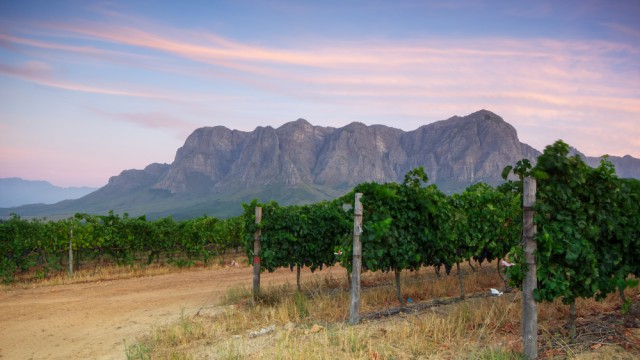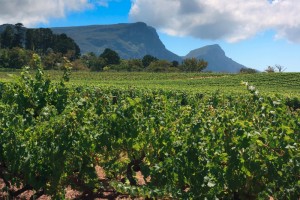“Today, praise be to God, wine was pressed for the first time from Cape grapes.”
Those were the words scribbled into the diary of the first Dutch commander of the Cape, Jan van Riebeeck. It was Feb. 2, 1659.
South Africa may still be referred to as one of the “New World” wine producers, but there is certainly a long history of wine making in the Western Cape province. And with some of the most scenic vineyards on the planet just a short drive from the Cape Town city center, it’s no surprise that most visitors to the Mother City spend at least a day – and often longer – exploring the magnificent wine lands.
Constantia
The first major vineyard plantings were in the area of modern-day Constantia; a suburb of Cape Town that continues to produce world-class wines. And, given that it’s just a 15-minute drive from the city centre, it’s also your best bet for a quick taste of what the Cape has to offer.
Today there are nine estates producing wine in Constantia, and the valley is especially known for its dry white wines and elegant reds.
Groot Constantia is a good place to start, and the original Manor House is widely regarded as the country’s finest surviving example of Cape Dutch architecture. Today it houses a cultural history museum. The estate’s modern tasting room is popular with large groups and offers daily tastings, with guided tours of the cellar available throughout the year.
Nearby you’ll find the newest cellars in the valley, with the likes of Eagle’s Nest and High Constantia becoming particularly known for their Shiraz, Viognier and Bordeaux-style blends.
Klein Constantia is another estate that few visitors miss out thank to its connection to the historic Vin de Constance. This sweet wine was first crafted in the 1800s and became the favoured tipple of the aristocracy across Europe. Napoleon drank it in exile, and it even makes an appearance in the Jane Austen classic ‘Sense and Sensibility’.
Vineyard disease saw the wine disappear from the world for over a century, until it was resurrected in the 1980s; a story you’ll hear all about from the expert tasting staff at Klein Constantia. The estate also produces wonderful white wines and an excellent red blend.
Next door, Buitenverwachting produces a wide range of varietals and is especially famous for elegant Bordeaux-style red blends, although the tasting room experience is not as refined as other Constantia estates. Not so at Steenberg Vineyards, where the modern cellar and tasting facility offer an impressive experience and knowledgeable staff.
Stellenbosch
The sprawling vineyards in and around the oak-lined streets of the university town of Stellenbosch are perhaps the most famous in South Africa, and wine has been made here for over 300 years.
The Stellenbosch Wine Route is also the oldest in the country and many of South Africa’s top producers are to be found here. With its hot climate, mountainous terrain, good rainfall and deep soils, the region is particularly famous for its Cabernet Sauvignon and red wine blends. The iconic South African varietal Pinotage was hybridised at Stellenbosch University; the only university in South Africa to offer a degree in viticulture and oenology.
Where to visit? Winemaker Beyers Naude from Beyerskloof is widely regarded as the king of Pinotage in South Africa, while nearby Kanonkop is also famous for its Pinotage and Bordeaux blends.
The cooler climes of the Helshoogte Pass sees some wonderful Syrah, Merlot and Chenin Blanc at Tokara, Thelema and Delaire Graff, while in the other direction, the likes of Jordan and DeMorgenzon have won renown for their Shiraz, Chenin Blanc and Chardonnay.
Franschhoek
The ‘French Corner’ lives up to its name with a reputation for joie de vivre and a taste for the finer things in life. The charming main street through town will remind many of the Napa Valley’s St. Helena, with its mix of upmarket bistros, boutiques and art galleries.
The valley is also home to some of the best wineries in the country: seek out Boekenhoutskloof, La Motte, and Chamonix for top-notch Syrah, Chardonnay, and Pinot Noir. Colmant, close to the town’s iconic Huguenot Monument, is renowned for their outstanding champagne-style wines.
Paarl & further afield
A short drive from Stellenbosch is the farming town of Paarl, where the oak-lined Main Road is worth exploring for its historic architecture and boutique hotels. The wineries in and around town make the most of the fiercely hot weather thanks to a range of microclimates around Paarl Mountain, with Shiraz and, of late, Mourvedre and Viognier winning the awards.
While the town is home to wine-producing giants KWV and Nederburg, there are plenty of boutique estates to explore. Black Pearl on the western edge of the mountain is worth a visit, while Ridgeback, Vondeling, and Diemersfontein are much-loved locally.
If you have time, the Swartland region to the north has become the brave new world of South African winemaking, with a crop of maverick young winemakers crafting world-class wines from aged bush vines. If you love Chenin Blanc, head for the Swartland.
And more…
While most visitors restrict themselves to these main wine-producing areas, keen vinophiles will be spoilt for choice when it comes to exploring further afield.
Robertson and the Breede River valley has little of the commercialism that defines many of the more popular wine regions, while up-and-coming wards like Elgin, Elim, and Walker Bay are famed for producing stellar cool-climate varietals including Chardonnay and Pinot Noir.
The annual Platter’s Guide is essential reading for anyone planning to spend a few days or weeks exploring the winelands. Visit http://www.wineonaplatter.com, or purchase a copy from any good bookstore on arrival.
Winelands FAQ
Do I need to book for tastings? The vast majority of estates are open throughout the day (usually Monday to Saturday) for walk-in visitors, although some boutique estates will be rl, “By Appointment Only.” Tourist maps of the wine regions, available at most estates, will have opening hours and contact details.
Are tastings free? Most estates in Paarl, Stellenbosch, and Franschhoek charge a nominal fee for tastings. Further afield, in Elgin, the Hemel-en-Aarde Valley, and around Robertson, tastings are usually free of charge.
Is it OK to drink and drive? No. South Africa’s blood alcohol limit allows for roughly one to two glasses of wine before you’re over the legal limit. Rather select a designated driver, or opt for a guided tour where you won’t need to drive.
Can I buy wine too? Absolutely. All estates offer cellar door sales, and will usually arrange shipping to your home country if required.


